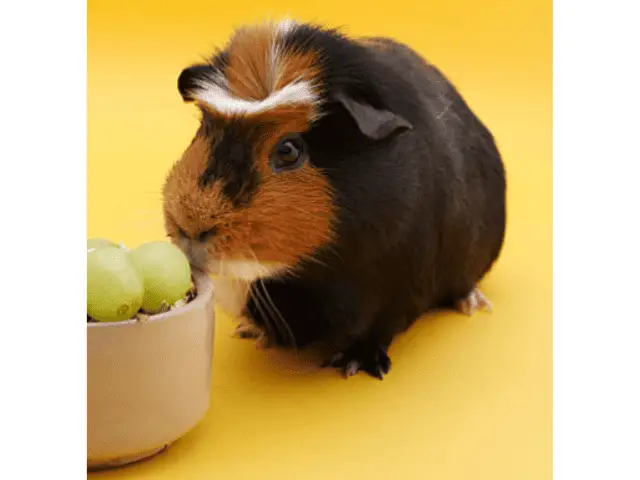Are you a guinea pig owner who’s wondering whether it’s okay to feed your furry friend grapes? Well, you’ve come to the right place!
Guinea pigs are adorable and lovable creatures, and as their caretaker, you want to make sure they are healthy and well-fed.
However, it can be confusing to know what foods are safe for them to eat and what foods should be avoided.
Grapes are a popular fruit that many of us enjoy eating. But can they be safely consumed by our guinea pig friends?
Guinea pigs can eat grapes, but they should be given in moderation. Grapes are high in sugar, so they should only be an occasional treat rather than a regular part of your guinea pig’s diet. It’s important to also provide your guinea pig with a balanced diet of hay, fresh vegetables, and pellets.
In this article, we’ll take a closer look at the nutritional value of grapes for guinea pigs, as well as the potential risks that come with feeding grapes to your furry little buddy.
We’ll also discuss how many grapes you should feed your guinea pig, and whether there are any alternatives to grapes that may be a better option.
So, whether you’re a seasoned guinea pig owner or new to the world of cavy care, read on to find out everything you need to know about feeding grapes to guinea pigs!

The Nutritional Value of Grapes for Guinea Pigs
Here are some of the key nutrients found in grapes and how they can benefit your guinea pig:
- Vitamin C: Just like humans, guinea pigs cannot produce their own vitamin C, and must obtain it through their diet. Grapes are a good source of vitamin C, which is essential for your guinea pig’s immune system, skin, and overall health.
- Fiber: Grapes contain both soluble and insoluble fiber, which can help keep your guinea pig’s digestive system healthy and prevent issues like constipation.
- Antioxidants: Grapes are rich in antioxidants such as flavonoids and resveratrol, which can help protect your guinea pig’s cells from damage caused by free radicals.
- Potassium: Grapes are a good source of potassium, which can help regulate your guinea pig’s blood pressure and support healthy kidney function.
While grapes do offer some nutritional benefits for guinea pigs, it’s important to keep in mind that they should not make up the majority of your pet’s diet.
Guinea pigs need a diet that is high in hay, fresh vegetables, and a small amount of pellets to stay healthy.
Additionally, grapes are high in sugar, which can lead to health issues such as obesity and dental problems if consumed in excess.
The Potential Risks of Feeding Grapes to Guinea Pigs
Here are some of the potential risks of feeding grapes to guinea pigs:
- Digestive issues: Grapes are high in sugar and can be difficult for guinea pigs to digest in large quantities, which can lead to diarrhea and other digestive issues.
- Obesity: Guinea pigs are prone to obesity, and feeding them too many grapes can contribute to weight gain and other health problems.
- Dental problems: The high sugar content of grapes can also lead to dental issues like overgrown teeth and cavities if consumed too frequently.
- Choking hazard: Grapes have a small size and a round shape, which can be a choking hazard for guinea pigs. Always make sure to cut grapes into small, bite-sized pieces before feeding them to your pet.
While it’s okay to offer your guinea pig a small amount of grapes as a treat, it’s important to do so in moderation and be mindful of the potential risks associated with feeding them this fruit.
If you notice any signs of digestive issues or other health problems in your guinea pig after feeding them grapes, consult your veterinarian.
Recommended Reading:
- Why Is My Guinea Pig Making Weird Noises? (All You Need To Know)
- Are Puppy Pads Safe For Guinea Pigs? (All You Need To Know)
- Keeping Two Guinea Pigs Together: Male-Female, Baby-Adult & More
- 7 Good Signs Of Guinea Pig Bonding: How To Bond + Bonding Behavior
- Why Is My Guinea Pig Not Pooping? (Constipation In Guinea Pigs)
Moderation is Key: How Many Grapes Can Guinea Pigs Eat?
Moderation is key when it comes to feeding grapes to guinea pigs. While grapes can offer some nutritional benefits and make for a tasty treat, it’s important not to overdo it.
Guinea pigs are small animals with sensitive digestive systems, so too many grapes can cause health problems like diarrhea, obesity, and dental issues.
A good rule of thumb is to offer your guinea pig no more than one or two small pieces of grape per week, and to make sure that grapes are not the main source of nutrition in their diet.
Instead, focus on feeding your guinea pig a balanced diet of hay, fresh vegetables, and pellets.
It’s also important to remember that not all guinea pigs will enjoy grapes, and some may not tolerate them well.
Always introduce new foods gradually and monitor your guinea pig for any signs of digestive issues or other health problems after feeding them grapes.
If you’re unsure about how many grapes to feed your guinea pig or have any concerns about their diet, consult your veterinarian.
They can provide personalized advice based on your guinea pig’s specific needs and health status.
Can Guinea Pigs Eat Purple Grapes?
Guinea pigs can eat purple grapes. The color of the grape does not affect its nutritional value or safety for guinea pigs.
As with any fruit, it’s important to feed grapes to your guinea pig in moderation and as part of a balanced diet.
Always remove any seeds or stems from the grapes and cut them into small, bite-sized pieces to avoid choking hazards.
If you’re unsure about introducing grapes or any other food to your guinea pig’s diet, consult with your veterinarian for personalized advice.
Alternatives to Grapes for Guinea Pigs
If you’re looking for alternative treats to give your guinea pig instead of grapes, there are plenty of options!
Here are a few healthy and tasty treats that your guinea pig is sure to love:
- Berries: Blueberries, strawberries, and raspberries are all low in sugar and high in vitamin C, making them a great choice for guinea pig snacks.
- Leafy greens: Guinea pigs love fresh greens like lettuce, spinach, and kale. These are also packed with essential nutrients that can help keep your pet healthy.
- Carrots: Carrots are a crunchy and nutritious treat that many guinea pigs enjoy. Just be sure to feed them in moderation, as they are high in sugar.
- Herbs: Fresh herbs like parsley, cilantro, and basil are a tasty and healthy treat for guinea pigs. These herbs are also rich in vitamins and minerals.
It’s important to remember that treats should only make up a small part of your guinea pig’s diet, and that their main source of nutrition should come from hay, fresh vegetables, and pellets.
Additionally, always introduce new foods gradually to avoid digestive upset, and be sure to remove any uneaten treats from your guinea pig’s cage to prevent spoilage.
Conclusion
In conclusion, guinea pigs can eat grapes, but they should be given in moderation.
While grapes offer some nutritional benefits, they are high in sugar and can contribute to health issues like obesity and dental problems if consumed in excess.
It’s important to provide your guinea pig with a balanced diet that is high in hay, fresh vegetables, and a small amount of pellets.
Additionally, if you’re looking for alternative treats to give your guinea pig, there are plenty of healthy options like berries, leafy greens, carrots, and herbs.
By feeding your guinea pig a varied and nutritious diet, you can help ensure that they stay happy and healthy for years to come.







